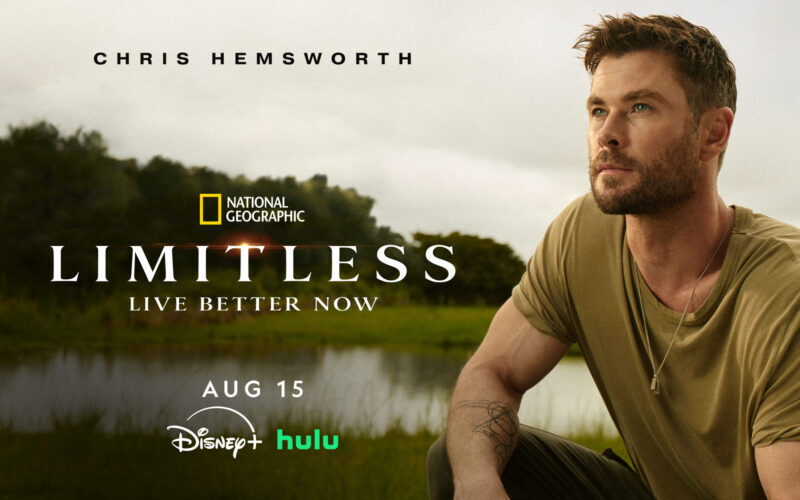Limitless: Live Better Now is the second installment of the innovative National Geographic docuseries with Chris Hemsworth about ways to live a longer and healthier life by taking on various physical and mental challenges while guided by experts. Produced by Darren Aranofsky for Disney+ and Hulu, it premieres streaming on August 15 then airs nationally August 25 on National Geographic.
In episode 2, titled “Pain”, hospice and palliative medicine physician BJ Miller took real care so that anything Chris had to endure was shy of toxic or injurious as they dialed up the intensity of the pain.
“It’s the same stimulus to everybody, but what it evinces is that everyone has a different pain threshold,” explained Miller. “We knew we weren’t taking risks with his life.”
Innovation & Tech Today got a sneak peek of this visceral episode followed by an exclusive interview with BJ Miller. In the conversation that follows, he offered some insights into his expertise on understanding pain and his involvement in the production.
This interview has been edited for length and clarity.
Innovation & Tech Today: What is the difference between acute and chronic pain?
BJ Miller: Acute pain lasts minutes to hours to a couple days. Chronic pain is ongoing, months or even years. So, the difference may be a matter of how long the pain’s been going. Acute pain is something to be respected as potentially a threat to injury, whereas oftentimes, chronic pain is no longer a threat and therefore something to be worked with differently.
I&TT: In terms of threats, how can the body tell when pain means danger?
BM: It’s not always clear, so if it’s a new pain, look for other signs of injury: immobility, for example, or bleeding. Usually in life, the pain will declare itself, whether it’s actually doing damage or not. But if it’s not so obvious, an x-ray, MRI, or physical exam can help you discern whether or not something is being injured.
I&TT: What is your personal experience understanding your pain threshold?
BM: I’m an amputee, so I have a bunch of chronic pain, neuropathy and phantom limb pains. I have mechanical or pressure pain from bearing weight on prosthetic legs. These sensations have become very familiar and I’ve gotten exquisitely good at knowing when to back off or to push through. I can modulate the experience from my emotional state through stories I tell myself or what I pursue to distract from the sensations.
I&TT: Is there a universal way for people to dictate their own pain threshold through personal experience or is it unique to each individual?
BM: There are universal sort of thematic issues around pain, but in the end, the experience is unique. The pain experience is a mashup of stimulus and physiology. Your peripheral nervous system, your emotional state, and existential state. The stories you weave, the meaning you make and the things that go into the experience of pain. How you or I navigate the emotional plane, how our history comes into the experience, or the stories we tell ourselves around pain. That is unique, that is subjective.


Reflection and recovery is crucial to a healthy psyche and body. Everyone struggles with this balance, from part time hustler to CEO of a multinational corporation. I can speak from … Continue reading
I&TT: Can you advise on any ways to actively engage with pain, specifically healthy exposure methods?
BM: Specifically held to the exposure methods, you know that you just got to be careful. That’s some serious training. You can overwhelm the system, and you can traumatize a system, and you can actually make your pain much, much worse. The difference there is sort of structured methodical exposure, gated exposure approach. Stuff of training, not just flinging yourself into the world and trying to cause [it] to find ways to hurt to get tougher. That doesn’t work.
I&TT: How does meditation separate pain from suffering using your thoughts?
BM: Meditation can help you put a little bit of space between the stimulus or what’s happening in the world and your reaction to it. If your mind is spastic, there is no time. There’s no choice in the matter. There’s little agency. You’re just a sort of a bundle of reflexes reacting to what’s happening. With meditation and other techniques of mindfulness, you can develop a little distance between the thing and your response to it. That opens up a little window of choice. It’s a practice, a muscle of sorts.
I&TT: What specific techniques and tools can help endure pain and why?
BM: Interventions. Playing a game. Being social, not isolated. Just being with your friends changes your experience of pain. Playfulness. A game doesn’t spell danger, that changes the storyline around what’s happening. Laughter is another way to lower the volume of pain and increase your pain tolerance. Change your narrative, change the experience, change your emotional state. That changes your experience.
I&TT: In regards to the advice from monks, how do you feel about reframing?
BM: I know [that] any one intervention is not necessarily going to be a magic bullet and protect you from the vagaries of pain forevermore. Buddhists—the monks in particular—have focused on the framing aspect of pain, and that is a very powerful one. That is a very accessible one. You or I can always do that by ourselves. We can always work on the stories we tell ourselves. We can always edit those stories and shift the experience of pain. It’s the most durable and the most accessible way to modulate the experience.
I&TT: Was there any methodology for the specific pain sensations that you chose to implement on Chris?
BM: It really has to do with the kinds of receptors that make up the pain experience. Chemical, pressure, and thermal. We know that food, that physiology, [has] chemo receptors. There are thermal receptors, so we wanted to do something with temperature. We used heat and cold. We also wanted to work with mechanical receptors, pressure receptors, and that’s a brute force. But then, of course, we know the sort of storylines and emotional aspects.

